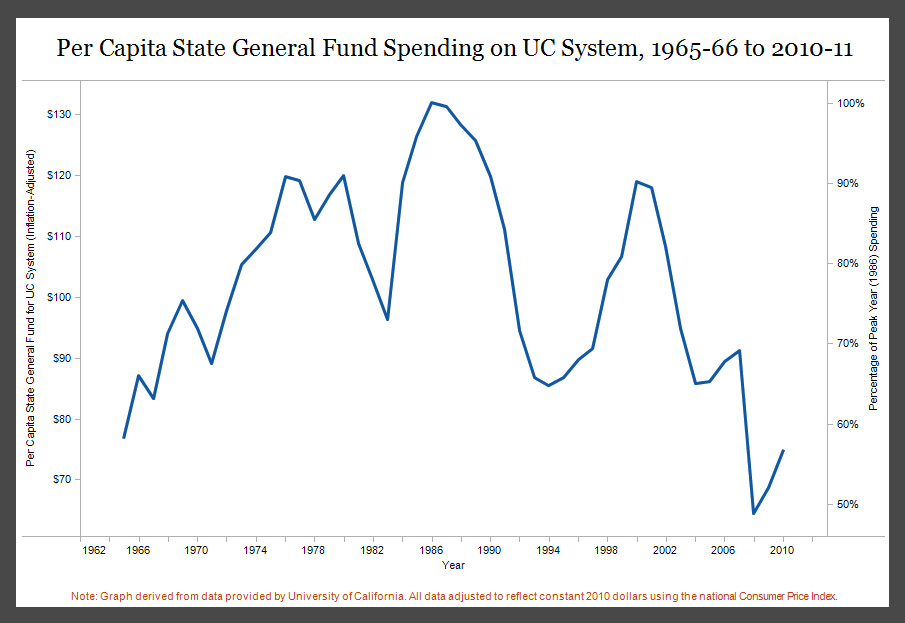Mission shrinking
Shifting the burden
The first significant erosion of support for the University of California began 30 years ago, when higher education funding, which had increased substantially in the years following the adoption of the 1960 Master Plan, fell steeply. From 1980 to 1983, per capita spending from the state General Fund fell to $96 from $120 — a drop of 20 percent (see graph below).
Beginning in 1990, the university started turning to students to make up for the losses. The balance between state general funds and student tuition began to shift, with the state paying less and students paying more. In 1990, student tuition for state residents at the University of California amounted to $2,362 in today’s dollars — roughly a fifth of the current level.
As state support fell (except for a brief recovery during the dot.com boom), the university also lost its competitive edge in recruitment, with faculty salaries lagging 3 to 22 percent behind comparable institutions, according to the Academic Senate’s 2006 study.
In 2010-11, state General Fund support for the University of California is now lower than it was in 1965, and is only 57% of the 1986 peak (see chart below).
“California’s public [higher] education segments,” John Aubrey Douglass, senior researcher at the Berkeley campus’s Center for Studies in Higher Education, wrote in a paper earlier this year, “have suffered from a million small cuts in their budgets over the past three or more decades. Now, the Great Recession has brought a bludgeoning budget-cutting blow.”
In November, the state’s Board of Regents adopted the term “tuition,” to reflect the steadily growing burden carried by students. It also approved the fourth in a series of tuition hikes that began in 2009, bringing the total increase in tuition for state residents to 57 percent as compared with tuition for the 2008-09 school year. In the 2011-12 school year, tuition will be just over $11,000, not including campus-based fees.
Of cuts and consequences
The decline in support has forced campuses to lay off 2,600 employees and eliminate some 1,400 positions. UCLA has dropped its writing requirements from two courses to one, and there is talk of eliminating even that. “That’s very worrisome,” said Christopher Santos, external vice president for the UCLA student association, which has been active in protesting the cuts and using student funds to make up shortfalls. “Whatever profession you end up in, it’s super important to write well.”
At the University of California’s ten campuses, course offerings are down — by 10 percent at UCLA between 2008 and 2009, and 8 percent at Berkeley. At UCLA, an initiative dubbed “Challenge 45” asks department chairs to pare down the classes required to major in their fields to 45 credits.
Student to faculty ratio is up system-wide by about 25 percent over the last 10 years, said Lawrence Pitts, provost and executive vice president. A comparison to the 1960s is even more startling: then, there was one faculty member for every 14 students; now, there is one for every 24 students.
With faculty workload rising, the university is also hiring fewer graduate students as teaching assistants. That leaves professors with less time available for student questions outside of class. Students report difficulty getting into courses, with lecture halls for mandatory core classes filled beyond capacity. Some students end up sitting on the floor for an entire semester, or waiting a year for an opening in a course required for their majors, Santos said.

